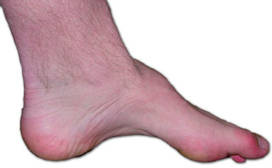What causes CMT?
Our nerves are responsible for relaying messages through electrical signals about sensation and motor function from our feet to the spinal cord and brain. The genes affected in CMT result in abnormalities in the structure and function of these nerves (particularly their axons and myelin sheaths), which affect the delivery of these messages and signals to the brain. These nerves degenerate and gradually, the muscles in the feet and legs weaken and the muscles begin to waste. This can make it difficult to walk and perform regular daily activities. If a parent has CMT, there is a 50% chance that their children will inherit the condition. Studies have also revealed some patients with CMT whose parents are not affected. There are multiple types of CMT based on the abnormalities produced in the neurons.What are the symptoms?
 vSymptoms vary but can include:
vSymptoms vary but can include:
- Muscle weakness and wasting
- Difficulty walking
- Fatigue
- Foot drop
- Pain
- Very high arched feet
- Hammertoes
- Neural symptoms (pins and needles, tingling, burning)
- Cramping
- Instability/poor balance
How is CMT treated?
Because the nerve damage is irreversible, treatment of CMT focuses on managing the symptoms as they arise. Your GP and podiatrist will work together to give you the best outcomes. This means that management will vary from person to person, but may include:- Orthotics to improve walking and stability
- Good footwear
- Braces to help with symptoms like foot drop
- Physical therapy to help regain muscle strength and stretch tight muscles and ligaments
- Surgery to help with foot deformities and prevent further complications
- Activity modification to lower-impact activities to reduce stress on the joints








